Pre-modern human migration
Paleolithic migration prior to end of the Last Glacial Maximum spread anatomically modern humans throughout Afro-Eurasia and to the Americas. During the Holocene climatic optimum, formerly isolated populations began to move and merge, giving rise to the pre-modern distribution of the world's major language families.
- This article focusses on prehistorical migration since the Neolithic period until AD 1800. See Early human migrations for migration prior to the Neolithic, History of human migration for modern history, and human migration for contemporary migration.
In the wake of the population movements of the Mesolithic came the Neolithic revolution, followed by the Indo-European expansion in Eurasia and the Bantu expansion in Africa.
Population movements of the proto-historical or early historical period include the Migration period, followed by (or connected to) the Slavic, Magyar, Norse, Turkic and Mongol expansions of the medieval period.
The last world regions to be permanently settled were the Pacific Islands and the Arctic, reached during the 1st millennium AD.
Since the beginning of the Age of Exploration and the beginning of the Early Modern period and its emerging colonial empires, an accelerated pace of migration on the intercontinental scale became possible.
Prehistory
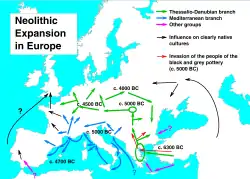
Neolithic to Chalcolithic
Agriculture is believed to have first been practised around 10,000 BC in the Fertile Crescent (see Jericho). From there, it propagated as a "wave" across Europe, a view supported by Archaeogenetics, reaching northern Europe some 5 millennia ago.
Some evidence (including a 2016 study by Busby et al.) suggests admixture from an ancient migration from Eurasia into parts of Sub-Saharan Africa.[1] Another study (Ramsay et al. 2018) also shows evidence that ancient Eurasians migrated into Africa and that Eurasian admixture in modern Sub-Saharan Africans ranges from 0% to 50%, varying by region and generally highest (after North Africa) in the Horn of Africa and parts of the Sahel zone.[2]
Bronze Age
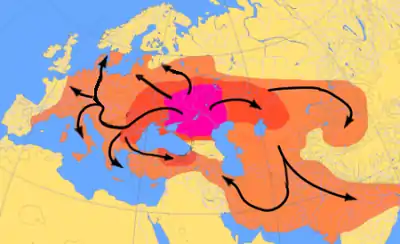
The proposed Indo-European migration has variously been dated to the end of the Neolithic (Marija Gimbutas: Corded Ware culture, Yamna culture, Kurgan culture), the early Neolithic (Colin Renfrew: Starčevo-Körös, Linearbandkeramic) and the late Palaeolithic (Marcel Otte, Paleolithic Continuity Theory).
The speakers of the Proto-Indo-European language are usually believed to have originated to the North of the Black Sea (today Eastern Ukraine and Southern Russia), and from there they gradually migrated into, and spread their language by cultural diffusion to, Anatolia, Europe, and Central Asia Iran and South Asia starting from around the end of the Neolithic period (see Kurgan hypothesis). Other theories, such as that of Colin Renfrew, posit their development much earlier, in Anatolia, and claim that Indo-European languages and culture spread as a result of the agricultural revolution in the early Neolithic.
Relatively little is known about the inhabitants of pre-Indo-European "Old Europe". The Basque language remains from that era, as do the indigenous languages of the Caucasus. The Sami are genetically distinct among the peoples of Europe, but the Sami languages, as part of the Uralic languages, spread into Europe about the same time as the Indo-European languages. However, since that period speakers of other Uralic languages such as the Finns and the Estonians have had more contact with other Europeans, thus today sharing more genes with them than the Sami.
The earliest migrations we can reconstruct from historical sources are those of the 2nd millennium BC. The Proto-Indo-Iranians began their expansion from c. 2000 BC, the Rigveda documenting the presence of early Indo-Aryans in the Punjab from the late 2nd millennium BC, and Iranian tribes being attested in Assyrian sources as in the Iranian plateau from the 9th century BC. In the Late Bronze Age, the Aegean and Anatolia were overrun by moving populations, summarized as the "Sea Peoples", leading to the collapse of the Hittite Empire and ushering in the Iron Age.
Austronesian expansion
.png.webp)
The islands of the Pacific were populated during c. 1600 BC and AD 1000. The Lapita people, who got their name from the archaeological site in Lapita, New Caledonia, where their characteristic pottery was first discovered, came from Austronesia, probably New Guinea, reaching the Solomon Islands, around 1600 BC, and later to Fiji, Samoa and Tonga. By the beginning of the 1st millennium BC, most of Polynesia was a loose web of thriving cultures who settled on the islands' coasts and lived off the sea. By 500 BC Micronesia was completely colonized; the last region of Polynesia to be reached was New Zealand in around 1000.
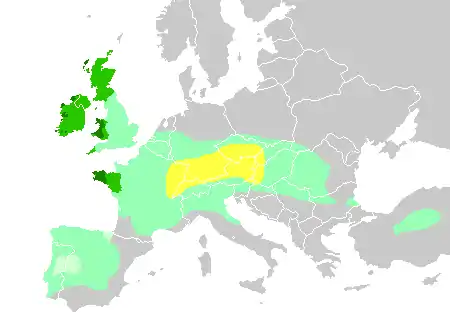
Bantu expansion
The Bantu expansion is the major prehistoric migratory pattern that shaped the ethno-linguistic composition of Sub-Saharan Africa.[3]
The Bantu, a branch of the Niger-Congo phylum, originated in West Africa around the Benue-Cross rivers area in southeastern Nigeria. Beginning in the 2nd millennium BC, they spread to Central Africa, and later, during the 1st millennium BC onward southeastern, spreading pastoralism and agriculture. During the 1st millennium AD, they populated Southern African. In the process, the Bantu languages displaced the Khoisan languages indigenous to Central and Southern Africa.
Arctic peoples
The final region to be permanently settled by humans was the Arctic, reached by the Dorset culture during about 500 BC to AD 1500. The Inuit are the descendants of the Thule culture, which emerged from western Alaska around AD 1000 and gradually displaced the Dorset culture.[4][5]
Proto-historical and early historical migration
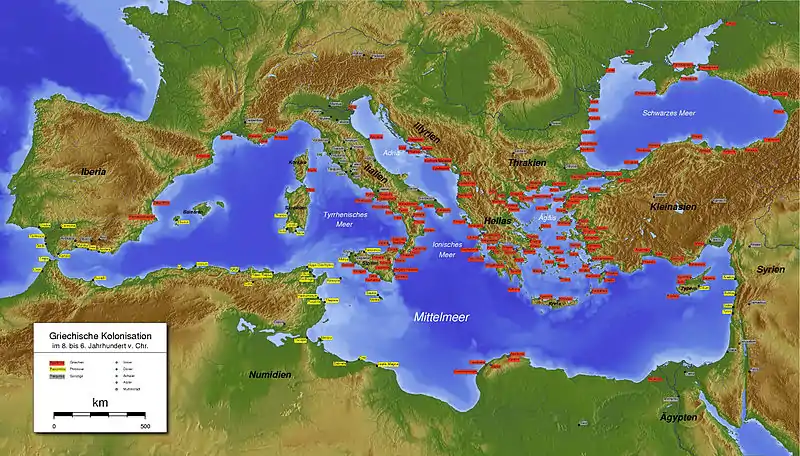
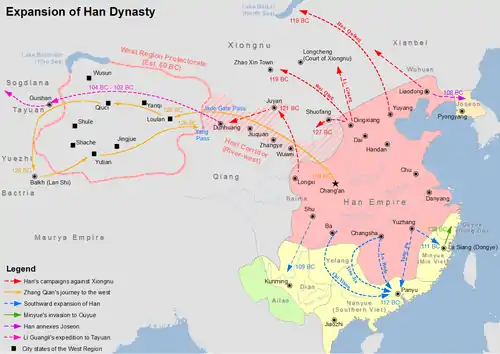
The German term Landnahme ("land-taking") is sometimes used in historiography for a migration event associated with a founding legend, e.g. of the conquest of Canaan in the Hebrew Bible, the Indo-Aryan migration and expansion within India alluded to in the Rigveda, the invasion traditions in the Irish Mythological Cycle, accounting for how the Gaels came to Ireland the arrival of the Franks in Austrasia during the Migration period, the Anglo-Saxon invasion of Britain, the settlement of Iceland in the Viking Age, the Slavic migrations, the Hungarian conquest , etc.
Iron Age
The Dorian invasion of Greece led to the Greek Dark Ages. The Urartians were displaced by Armenians, and the Cimmerians and the Mushki migrated from the Caucasus into Anatolia. A Thraco-Cimmerian connection links these movements to the Proto-Celtic world of central Europe, leading to the introduction of Iron to Europe and the Celtic expansion to western Europe and the British Isles around 500 BC.
Migration period
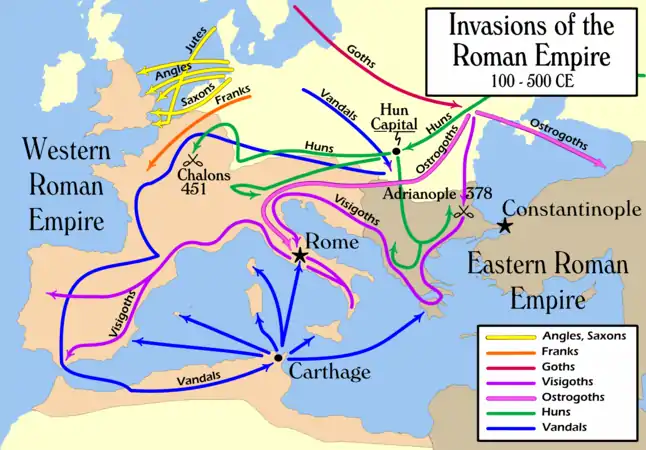
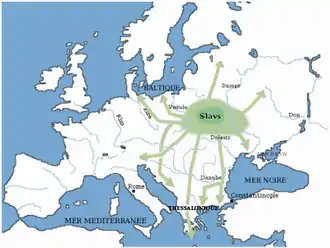
Western historians refer to the period of migrations that separated Antiquity from the Middle Ages in Europe as the Great Migrations or as the Migrations Period. This period is further divided into two phases.
The first phase, from 300 to 500, saw the movement of Germanic, Sarmatian and Hunnic tribes and ended with the settlement of these peoples in the areas of the former Western Roman Empire. (See also: Ostrogoths, Visigoths, Burgundians, Suebi, Alamanni, Marcomanni).
The second phase, between 500 and 900, saw Slavic, Turkic and other tribes on the move, re-settling in Eastern Europe and gradually making it predominantly Slavic. Moreover, more Germanic tribes migrated within Europe during this period, including the Lombards (to Italy), and the Angles, Saxons, and Jutes (to the British Isles). See also: Avars, Bulgars, Huns, Arabs, Vikings, Varangians. The last phase of the migrations saw the coming of the Hungarians to the Pannonian plain.
German historians of the 19th century referred to these Germanic migrations as the Völkerwanderung,[6] the migrations of the peoples.
The European migration period is connected with the simultaneous Turkic expansion which at first displaced other peoples towards the west, and by High Medieval times, the Seljuk Turks themselves reached the Mediterranean.
Early medieval period
The medieval period, although often presented as a time of limited human mobility and slow social change in the history of Europe, in fact saw widespread movement of peoples. The Vikings from Scandinavia raided all over Europe from the 8th century and settled in many places, including Normandy, the north of England, Scotland and Ireland (most of whose urban centres were founded by the Vikings). The Normans later conquered the Saxon Kingdom of England, most of Ireland, southern Italy and Sicily.
Iberia was invaded by Muslim Arabs, Berbers and Moors in the 8th century, founding new Kingdoms such as al Andalus and bringing with them a wave of settlers from North Africa. The invasion of North Africa by the Banu Hilal, a warlike Arab Bedouin tribe, was a major factor in the linguistic, cultural Arabization of the Maghreb.
Late Middle Ages
Massive migrations of Germans took place into East Central and Eastern Europe, reaching its peak in the 12th to 14th centuries. These Ostsiedlung settlements in part followed territorial gains of the Holy Roman Empire, but areas beyond were settled, too.
At the end of the Middle Ages, the Romani (gypsies) arrived in Europe from the Middle East. They originate in India, probably an offshoot of the Domba people of Northern India who had left for Sassanid Persia around the 5th century.
Early Modern period
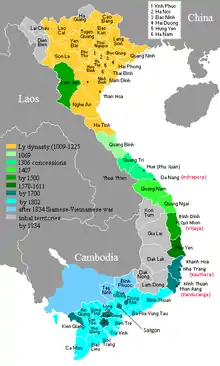
Early Modern Europe
Internal European migration stepped up in the Early Modern Period. In this period, major migration within Europe included the recruiting by monarchs of landless laborers to settle depopulated or uncultivated regions and a series of forced migration caused by religious persecution. Notable examples of this phenomenon include the expulsion of the Jews from Spain in 1492, mass migration of Protestants from the Spanish Netherlands to the Dutch Republic after the 1580s, the expulsion of the Moriscos (descendants of former Muslims) from Spain in 1609, and the expulsion of the Huguenots from France in the 1680s.[6] Since the 14th century, the Serbs started leaving the areas of their medieval Kingdom and Empire that was overrun by the Ottoman Turks and migrated to the north, to the lands of today's Vojvodina (northern Serbia), which was ruled by the Kingdom of Hungary at that time. The Habsburg monarchs of Austria encouraged them to settle on their frontier with the Turks and provide military service by granting them free land and religious toleration. The two greatest migrations took place in 1690 and 1737. Other instances of labour recruitments include the Plantations of Ireland - the settling of Ireland with Protestant colonists from England, Scotland and Wales in the period 1560–1690 and the recruitment of Germans by Catherine the Great of Russia to settle the Volga region in the 18th century.
Colonial empires
European Colonialism from the 16th to the early 20th centuries led to an imposition of a European colonies in many regions of the world, particularly in the Americas, South Asia, Sub-Saharan Africa and Australia, where European languages remain either prevalent or in frequent use as administrative languages. Major human migration before the 18th century was largely state directed. For instance, Spanish emigration to the New World was limited to settlers from Castile who were intended to act as soldiers or administrators. Mass immigration was not encouraged due to a labour shortage in Europe (of which Spain was the worst affected by a depopulation of its core territories in the 17th century).
Europeans also tended to die of tropical diseases in the New World in this period and for this reason England, France and Spain preferred using slaves as free labor in their American possessions. Many historians attribute a change in this pattern in the 18th century to population increases in Europe.
However, in the less tropical regions of North America's east coast, large numbers of religious dissidents, mostly English Puritans, settled during the early 17th century. Spanish restrictions on emigration to Latin America were revoked and the English colonies in North America also saw a major influx of settlers attracted by cheap or free land, economic opportunity and the continued lure of religious toleration.
A period in which various early English colonies had a significant amount of self-rule prevailed from the time of the Plymouth colony's founding in 1620 through 1676, as the mother country was wracked by revolution and general instability. However, King William III decisively intervened in colonial affairs after 1688 and the English colonies gradually came more directly under royal governance, with a marked effect on the type of emigration. During the early 18th century, significant numbers of non-English seekers of greater religious and political freedom were allowed to settle within the British colonies, including Protestant Palatine Germans displaced by French conquest, French Huguenots disenfranchised by an end of religious tolerance, Scotch-Irish Presbyterians, Quakers who were often Welsh, as well as Presbyterian and Catholic Scottish Highlanders seeking a new start after a series of unsuccessful revolts.
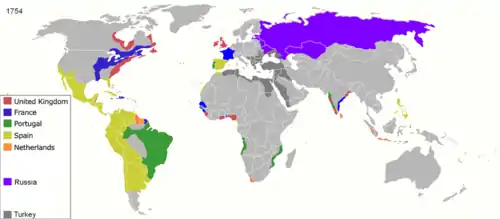
The English colonists who came during this period were increasingly moved by economic necessity. Some colonies, including Georgia, were settled heavily by petty criminals and indentured servants who hoped to pay off their debts. By 1800, European emigration had transformed the demographic character of the American continent. This was due to the devastating effect of European diseases and warfare on Native American populations.
The European settlers' influence elsewhere was less pronounced as in South Asia and Africa, European settlement in this period was limited to a thin layer of administrators, traders and soldiers.
Further reading
- Reich, David (2018). Who We Are And How We Got Here - Ancient DNA and the New Science of the Human Past. Pantheon Books. ISBN 978-1101870327.[7]
References
- Busby, George BJ; Band, Gavin; Si Le, Quang; Jallow, Muminatou; Bougama, Edith; Mangano, Valentina D; Amenga-Etego, Lucas N; Enimil, Anthony; Apinjoh, Tobias (2016). "Admixture into and within sub-Saharan Africa". eLife. 5. doi:10.7554/eLife.15266. ISSN 2050-084X. PMC 4915815. PMID 27324836.
- Ramsay, Michèle; Hazelhurst, Scott; Sengupta, Dhriti; Aron, Shaun; Choudhury, Ananyo (2018-08-01). "African genetic diversity provides novel insights into evolutionary history and local adaptations". Human Molecular Genetics. 27 (R2): R209–R218. doi:10.1093/hmg/ddy161. ISSN 0964-6906. PMC 6061870. PMID 29741686.
- Oliver, Roland (1966). "The Problem of the Bantu Expansion". The Journal of African History. 7 (3): 361. doi:10.1017/S0021853700006472. JSTOR 180108. "four stages of the Bantu expansion: first, the initial push through the equatorial forest from the northern to the southern woodlands; second, the occupation of the southern woodland belt from coast to coast; third, the colonization of the Tanzania, Kenya and southern Somali coastline and of the northern sector of the lake region; fourth, the colonization south-wards, north-westwards and north-eastwards from this extended nucleus."
- Rigby, Bruce. "101. Qaummaarviit Historic Park, Nunavut Handbook" (PDF). Archived from the original (pdf) on 2006-05-29. Retrieved 2009-10-02.
- Wood, Shannon Raye (April 1992). "Tooth Wear and the Sexual Division of Labour in an Inuit Population" (pdf). Department of Archaeology University of Saskatchewan. Simon Fraser University. Retrieved 2009-10-02.
- Mayo-Smith, Richmond; Ingram, Thomas Allan (1911). . In Chisholm, Hugh (ed.). Encyclopædia Britannica. 18 (11th ed.). Cambridge University Press. p. 428.
- Diamond, Jared (April 20, 2018). A Brand-New Version of Our Origin Story. The New York Times. Retrieved April 23, 2018.